Trending
Opinion: How will Project 2025 impact game developers?
The Heritage Foundation's manifesto for the possible next administration could do great harm to many, including large portions of the game development community.
How do you make a puzzler that sticks? Iterate, iterate, and then iterate some more.
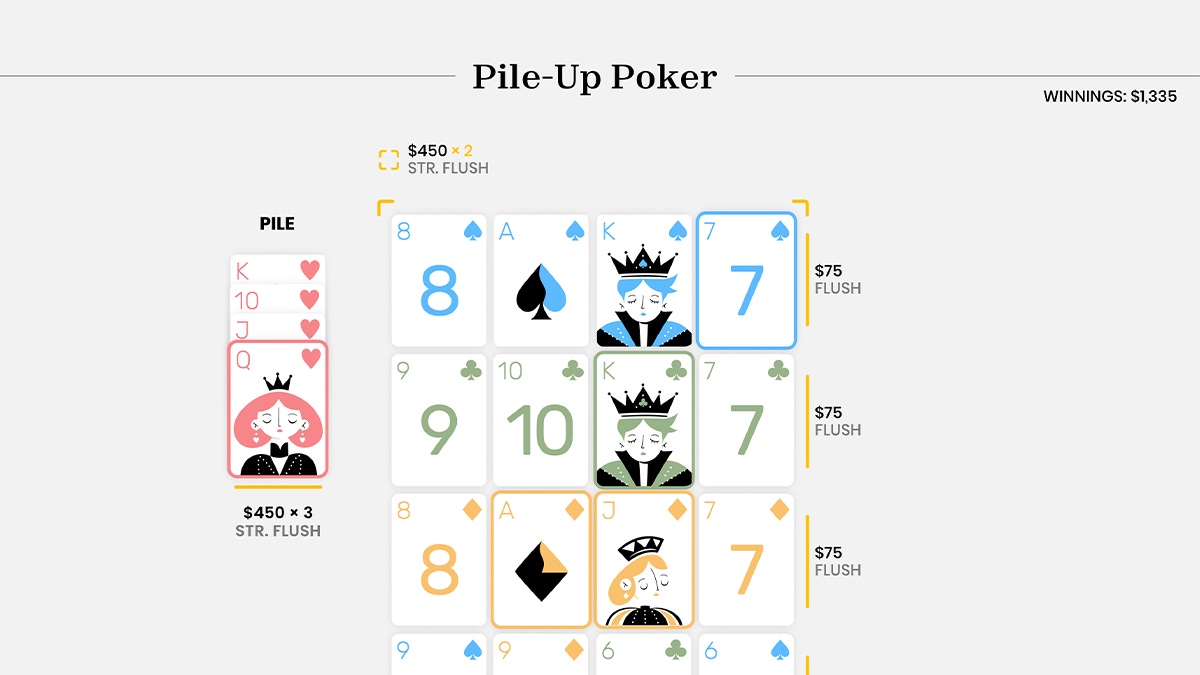
Psst. Do you want to know how Puzzmo co-creator Zach Gage prototyped his latest project? We thought you might. Earlier this month, we sat down with the TypeShift and Knotwords designer to learn more about his new bitesized newspaper puzzler, Pile-up Poker (PUP).
During our chat, Gage explained how the project changed dramatically throughout production–bouncing back from a brief cancellation to become one of the most popular offerings on Hearst's burgeoning puzzle platform.
We also glimpsed four work-in-progress versions of Pile-up Poker that provide a clear look at how the project became waylaid before being reshaped into something much more approachable.
Gage has kindly granted us permission to share images of those early incarnations, along with his annotations, to help you understand why the title was scrapped and subsequently reforged, eventually becoming the experimental card-based conundrum you see today.
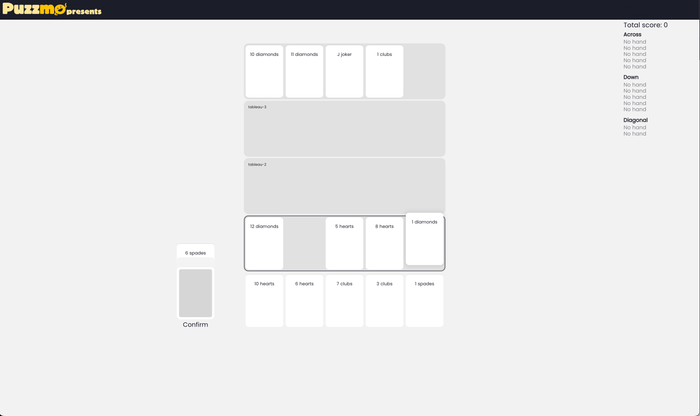
This was the earliest playable version of the game. Gage notes that with this initial prototype, his goal was to "get a digital version [out] as fast as possible and to focus more on aiding playability than adding constraints."
"In this version we could place cards anywhere on the grid. When we tested this, pretended there were rules around placement instead of implementing them with code," he adds. "This made it quicker to program and preserved more flexibility for us to make and try rule changes in our heads (without needing code changes)."
Below are the rules of this first iteration:
You may move up to four cards per turn Cards may be moved to the top most empty row, or any row already containing cards
You may not move cards to multiple rows at the same time
Each turn you may only move up to n-1 cards, where n is the number you moved last turn. So if I moved three cards on turn one, I could only move up to two on turn two
Once you "stand" your moves are reset back to four and you are dealt the next hand up
The goal here, according to Gage, was to try and make the best 12 poker hands (based on horizontal, vertical, and diagonal matches). The joker was a wild-card that counted as the best card for each different hand it featured in. The card peeking out of the back of the draw pile was the last card players would draw.
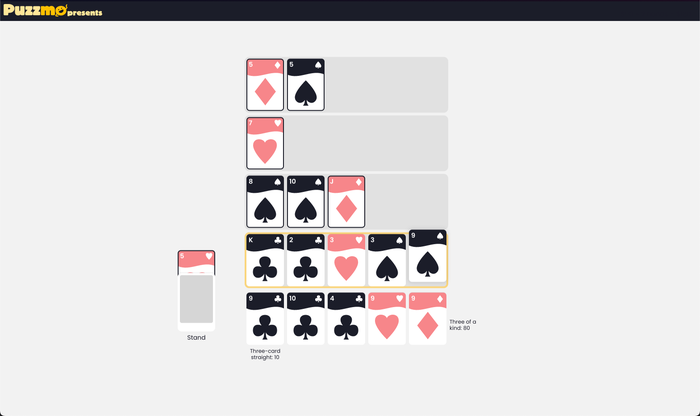
At this stage, the Puzzmo team were enjoying PUP-0 so focused on improving playability by including "more legible card-art, implementing a multiplier based on how many hands you've made, and showing the hand information next to each scored hand."
"You can see a lot of design ideas from this version made their way into the final version of the game. If you're really eagle-eyed you might notice that the suit-art and cards we used in this version are pulled right out of Flipflop Solitaire," adds Gage.
"These prior iterations of the game were very technical to play and good strategy involves using the cards you discard to line things up vertically, since the cards shift left to fill gaps."
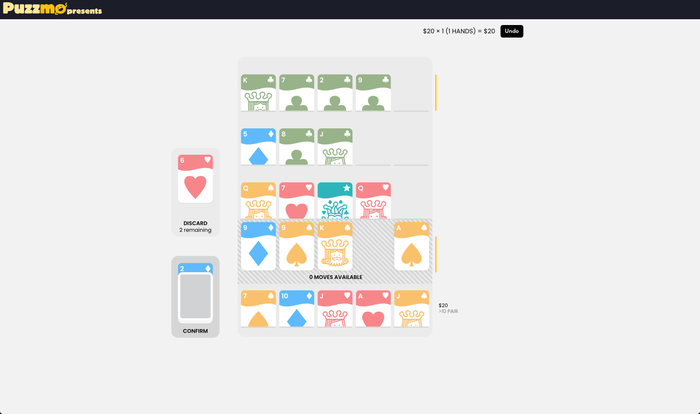
A big change in this version saw Gage experiment with the idea of a "discard to the void" move that players could deploy while also shifting cards up the board.
"We had three true discards for the whole game, and using them counted as a move (for both the number of moves we'd get next turn, and the number of moves we had this turn)," continues Gage.
"The goal with this idea was to make the end-rounds of the game feel less railroad-y. We were finding that the final two turns of the game had almost no decision-points. Adding in the optional discard, if players preserved it to the end, really opens up the end-game."
The Puzzmo team also continued to add visual polish with PUP–v2, using outlines to clarify where you could place cards. The yellow bars denote 'bonus hands,' which are randomized each game and worth 2x the value of all other hands.
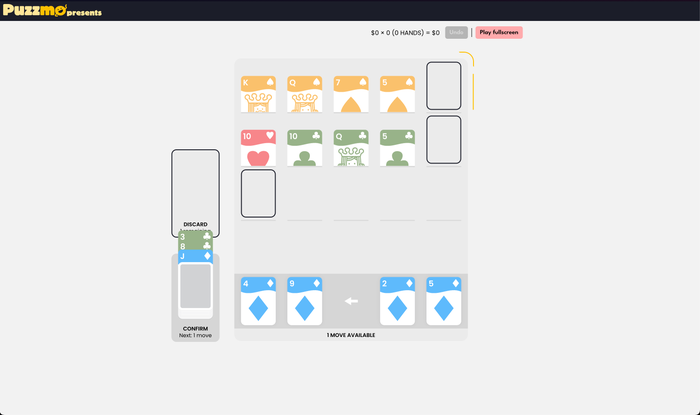
Gage says PUP-v3 is where things began to get a "little weird and/or unhinged." A big change saw the team try moving discarded cards to the back of the draw-deck instead of the void.
"Instead of deleting cards, we're passing them to ourselves later," explains Gage. "This enables a ton of really interesting strategies around the discard move and creates a very interesting and dynamic end-game. Suddenly we had to balance our current row, the spots we can move cards to, and the 1-4 cards we've discarded against each-other.
"Ultimately, this version of the game is the most technical and the most interesting, but it felt to me like too much work to play, and even worse, too much work to explain."
The complexity seen in PUP–v3 drove Gage to (briefly) cancel the project. It was, of course, pulled back from the brink after the Puzzmo team offered a few choice pointers that helped Gage reshape Pile-up Poker into something altogether more fluid.
For more on what happened next, read our full interview with Gage.
You May Also Like